
NGC 1705 is a peculiar lenticular galaxy and a blue compact dwarf galaxy (BCD) in the southern constellation of Pictor, positioned less than a degree to the east of Iota Pictoris, and is undergoing a starburst. With an apparent visual magnitude of 12.6 it requires a telescope to observe. It is estimated to be approximately 17 million light-years from the Earth, and is a member of the Dorado Group.

NGC 2787 is a barred lenticular galaxy approximately 24 million light-years away in the northern constellation of Ursa Major. It was discovered on December 3, 1788 by German-born astronomer William Herschel. J. L. E. Dreyer described it as, "bright, pretty large, a little extended 90°, much brighter middle, mottled but not resolved, very small (faint) star involved to the southeast". The visible galaxy has an angular size of 2.5 × 1.5 arcminutes or 3.24 × 1.81 arcminutes and an apparent visual magnitude of 11.8.

NGC 4526 is a lenticular galaxy with an embedded dusty disc, located approximately 55 million light-years from the Solar System in the Virgo constellation and discovered on 13 April 1784 by William Herschel.
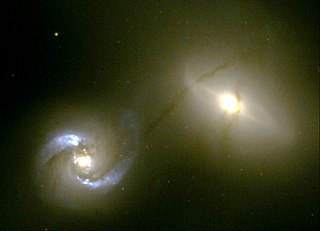
NGC 1409 is a quiescent lenticular galaxy in the equatorial constellation of Taurus. It was discovered by the German-born astronomer William Herschel on January 6, 1785. NGC 1409 is located in close proximity to the smaller Seyfert galaxy NGC 1410, and the two are strongly interacting. Their respective nuclei have a separation of just 23 kly, and they share a diffuse stellar envelope with a radius extending out to 49 kly.

NGC 3593 is a lenticular galaxy located in the constellation Leo. It has a morphological classification of SA(s)0/a, which indicates it is a lenticular galaxy of the pure spiral type. Despite this, it has a large amount of hydrogen, both in its molecular and atomic (H) form. It is a starburst galaxy, which means it is forming new stars at a high rate. This is occurring in a band of gas surrounding the central nucleus. There is a single arm, which spirals outward from this ring. It is frequently but not consistently identified as a member of the Leo Triplet group.

NGC 89 is a barred spiral or lenticular galaxy, part of Robert's Quartet, a group of four interacting galaxies.
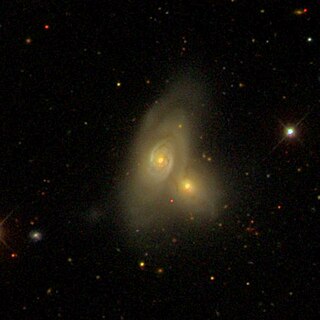
NGC 5930 is a starburst galaxy in the constellation Boötes that is interacting with the nearby Seyfert galaxy NGC 5929. 5930 has a morphological classification of SAB(rs)b pec, indicating that it is a weakly-barred spiral galaxy with a poorly defined nuclear ring structure. It is inclined at an angle of 46° to the line of sight from the Earth.

NGC 5929 is a Seyfert galaxy in the constellation Boötes. The pair of galaxies, NGC 5929 and NGC 5930, are interacting.

NGC 3539 is a lenticular galaxy in the constellation Ursa Major. It was discovered in April 1831 by John Herschel. It is a member of the galaxy cluster Abell 1185.
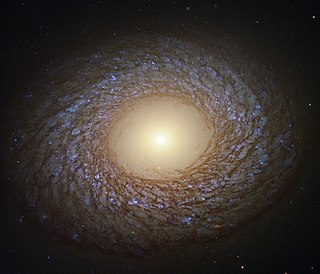
NGC 2775, also known as Caldwell 48, is a spiral galaxy in the constellation Cancer. It is 67 million light-years away from the Milky Way. It was discovered by William Herschel in 1783. NGC 2775 belongs to the Antlia-Hydra Cluster of galaxies and is the most prominent member of the NGC 2775 Group, a small galaxy group in the Virgo Super-cluster, along with the Local Group. Other members of the NGC 2775 Group include NGC 2777 and UGC 4781.

NGC 59 is a lenticular galaxy in the constellation Cetus. It is a probable member of the Sculptor Group. It is approximately 17 million light-years away.

NGC 4036 is the New General Catalogue identifier for a lenticular galaxy in the northern circumpolar constellation of Ursa Major. In the Carnegie Atlas of Galaxies, it is described as being "characterized by an irregular pattern of dust lanes threaded through the disc in an 'embryonic' spiral pattern indicating a mixed S0/Sa form." It is located near the Big Dipper, a little to the north of the mid-way point between the stars Alpha Ursae Majoris and Delta Ursae Majoris. With a visual magnitude of 10.7, it can be dimly viewed using a 4 in (10 cm) aperture telescope.

NGC 4293 is a lenticular galaxy in the northern constellation of Coma Berenices. It was discovered by English astronomer William Herschel on March 14, 1784, who described it as "large, extended, resolvable, 6 or 7′ long". This galaxy is positioned to the north-northwest of the star 11 Comae Berenices and is a member of the Virgo Cluster of galaxies. It is assumed to lie at the same distance as the Virgo Cluster itself: around 54 million light years away. The galaxy spans an apparent area of 5.3 × 3.1 arc minutes.

NGC 4138 is the New General Catalogue identifier for a lenticular galaxy in the northern constellation of Canes Venatici. Located around 52 million light years from Earth, it spans some 2.1 × 1.3 arc minutes and has an apparent visual magnitude of 11.3. The morphological classification of NGC 4138 is SA0+(r), indicating it lacks a bar formation and has tightly wound spiral arms with a ring-like structure around the nucleus. It has no nearby companion galaxies.

NGC 4203 is the New General Catalogue identifier for a lenticular galaxy in the northern constellation of Coma Berenices. It was discovered on March 20, 1787 by English astronomer William Herschel, and is situated 5.5° to the northwest of the 4th magnitude star Gamma Comae Berenices and can be viewed with a small telescope. The morphological classification of NGC 4203 is SAB0−, indicating that it has a lenticular form with tightly wound spiral arms and a weak bar structure at the nucleus.
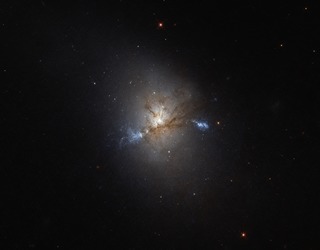
NGC 1222 is an early-type lenticular galaxy located in the constellation of Eridanus. The galaxy was discovered on 5 December 1883 by the French astronomer Édouard Stephan. John Louis Emil Dreyer, the compiler of the New General Catalogue, described it as a "pretty faint, small, round nebula" and noted the presence of a "very faint star" superposed on the galaxy.

NGC 1326 is a lenticular galaxy in the constellation Fornax, 63 million light-years away. It was discovered by English astronomer John Herschel on 29 November 1837. It is a member of the Fornax Cluster, an NGC 1316 subgroup and has a diameter of 70 000 light-years.

NGC 770 is an elliptical galaxy in the constellation Aries. It is around 120 million light years from the Milky Way and has a diameter of around 36,000 ly. NGC 770 is gravitationally linked to NGC 772. The galaxy was discovered on November 3, 1855 by RJ Mitchell.
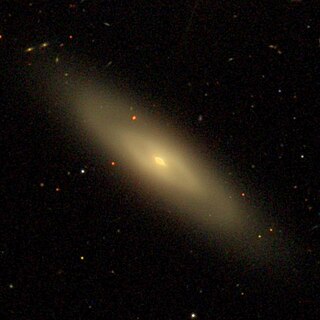
NGC 3301, also known as NGC 3760, is a lenticular galaxy in the constellation Leo. Its apparent magnitude in the V-band is 11.1. It was first observed on March 12, 1784, by the astronomer William Herschel. It is a member of the Leo II Groups, a series of galaxies and galaxy clusters strung out from the right edge of the Virgo Supercluster.

NGC 3073 is a dwarf lenticular galaxy in the constellation Ursa Major. It is at a distance of about 65 million light-years from Earth. NGC 3073 was discovered by astronomer William Herschel on April 1, 1790. The galaxy belongs to the NGC 3079 Group.




















